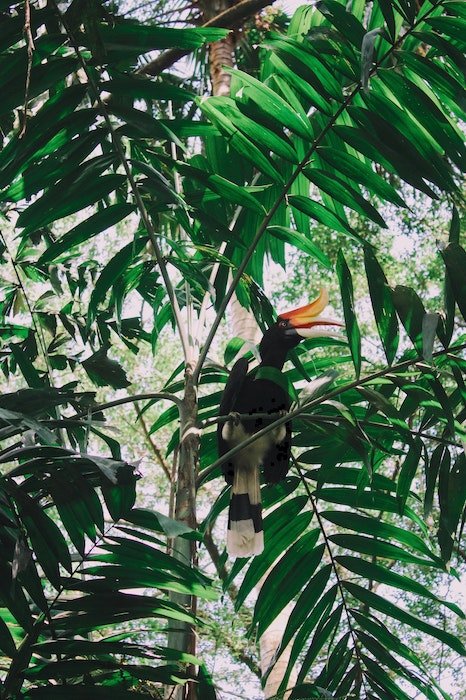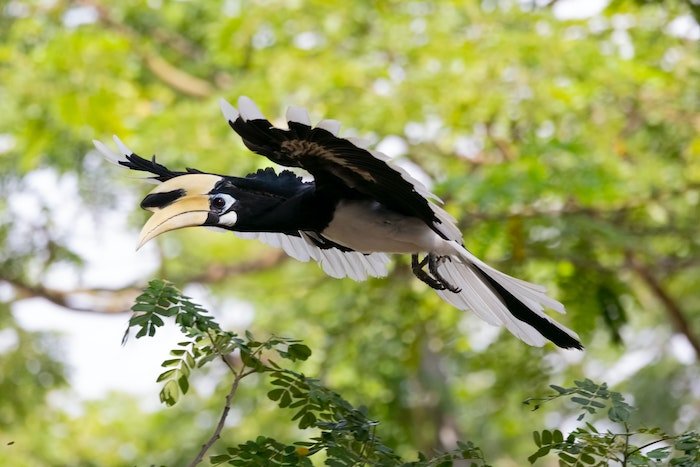Banana or Bird?
Bucerotidae
by Inspector Barry Mins on December 20, 2022Hey kids, welcome back to our series on the mysteries of created kinds. Last week we met a diverse kind of medium-size mammal. This week we’re moving on to birds with feisty tempers and loud voices.

These birds are found throughout Africa and south Asia. They tend to live in forests, preferably ones undisturbed by development, though they will use human gardens when needed.1 Larger, more established trees are preferred.2 Home ranges vary depending on the species and the time of year.3 Some species also migrate to new areas to breed.4 When foraging, they are alert to other species around them, monitoring alarm calls from other organisms. They can even determine from the alarms whether the predator is threatening to them or not.5
This kind is largely omnivorous but finds fruit particularly appealing. Figs are a major part of some species’ diets.6 Other species are more aggressive, raiding the nests of other birds.7 On occasion, they will even kill one of their own chicks that is not developing and feed it to the other chicks.8 Other species include lizards and invertebrates in their diet.9 Because they eat so many fruits, many of this kind serve as excellent seed dispersers for plants.10
When this kind mates, the females will build the nest and then seal themselves inside.11 Males will then bring food to the females and hatchling chicks an average of nine times a day!12 Occasionally, they will have two broods in one mating season.13 Males will fight for the right to mate. At least one species will go so far as to engage in arial jousting matches where they butt their specialized casques against each other.14
Has anyone figured it out yet? This week’s kind is the Bucerotidae—the hornbills. You have probably seen an example of these birds in your local zoo or aviary. If you have, you know they are loud! Stay tuned for next week when we start looking for a small family of amphibians.
Clue
Your clue for the week is:
These toads get their name from the shape of their hind legs which they use for burrowing.
Ask a Question
Have you ever had a question about created kinds but didn’t know who to ask? Have you ever wanted to learn more about your favorite kind? Well, now you can! You can ask me, Inspector Barry Mins, a question! Have your parents help you fill out this form, and you might get your question answered in my column! If you have any questions about created kinds, feel free to send them my way!
Footnotes
- M. Chibesa, B. Taylor, T. Ramesh, and C. T. Downs, “Home range and habitat use of Trumpeter Hornbills Bycanistes bucinator in an urban-forest mosaic, Eshowe, South Africa,” Ostrich 88, no. 3 (2017): 1–9.
- A. R. T. Reintar, L. J. Paguntalan, P. G. C. Jakosalem, A. C. D. Quidet, D. A. Warguez, and E. Peñaranda, “Habitat preference and population density of threatened Visayan hornbills Penelopides panini and Rhabdotorrhinus waldeni in the Philippines,” Journal of Threatened Taxa 14, no. 3 (2022): 20713–20720.
- P. Poonswad and A. Tsuji, “Ranges of males of the great hornbill Buceros bicornis, Brown hornbill Ptilolaemus tickelli and Wreathed hornbill Rhyticeros undulatus in Khao Yai National Park, Thailand,” Ibis 136, no. 1 (1994): 79–86.
- N. Das, “Seasonal Migration of Great Hornbill Buceros Bicornis in the High Forest Areas of Nameri National Park,” Bird Populations 13 (2014): 6–9.
- H. J. Rainey, K. Zuberbühler, and P. J. B. Slater, “The Responses of Black-Casqued Hornbills to Predator Vocalisations and Primate Alarm Calls,” Behaviour 141, no. 10 (2004): 1263–1277.
- P. Balasubramanian, R. Saravanan, and B. Maheswaran, “Fruit preferences of Malabar Pied Hornbill Anthracoceros coronatus in Western Ghats, India,” Bird Conservation International 14, no. S1 (December 2004) S69–S74.
- S. Loong, Y. C. K. Sin, P. M. Johns, T. Plowden, D. L. Yong, J. G. Lee, and A. Jain, “Nest predation by Oriental Pied Hornbills Anthracoceros albirostris in urban Singapore,” Birding Asia 35 (June 2021): 86–91.
- Y. H. Chan, M. Zafirah, M. Cremades, M. Divet, C. H. R. Teo, and S. C. Ng, “Infanticide-cannibalism in the Oriental Pied Hornbill Anthracoceros albirostris,” Forktail 23 (2007): 170–173.
- N. J. Cordeiro, J. T. Campbell, and H. J. Ndangalasi, “Diet of the Silvery-cheeked Hornbill Bycanistes brevis during the breeding season in the East Usambara Mountains, Tanzania,” Ostrich 87, no. 1 (2016): 67–72.
- K. D. Whitney, M. K. Fogiel, A. M. Lamperti, K. M. Holbrook, D. J. Stauffer, B. D. Hardesty, V. T. Parker, and T. B. Smith, “Seed dispersal by Ceratogymna hornbills in the Dja Reserve, Cameroon,” Journal of Tropical Ecology 14, no. 3 (May 1998): 351–371.
- M. S. Diop and B. Treca, “Distribution of nest preparation tasks between mates of the redbilled hornbill Tockus erythrorhynchus,” Ostrich 67, no. 2 (1996): 55–59.
- F. Rahman, A. Ismail, and M. J. Nurul-Huda, “Food Items and Foraging Sites of the Oriental Pied-Hornbill (Anthracoceros albirostris) during Breeding Season in Sungai Panjang, Sabak Bernam, Malaysia,” Journal of Tropical Agriculture Science 42, no. 1 (2019): 251–259.
- M. T. Stanback, D. Millican, W. Versfeld, M. Nghikembua, L. L. Marker, and J. Mendelsohn, “Double-brooding in Southern Yellow-billed Hornbills Tockus leucomelas,” Ostrich 92, no. 2 (March 2021): 1–8.
- T. R. S. Raman, “Aerial casque-butting in the Great Hornbill Buceros bicornis,” Forktail 13 (1998): 123–124.
- © 2024 Answers in Genesis
- Privacy Policy
- Contact
- About


